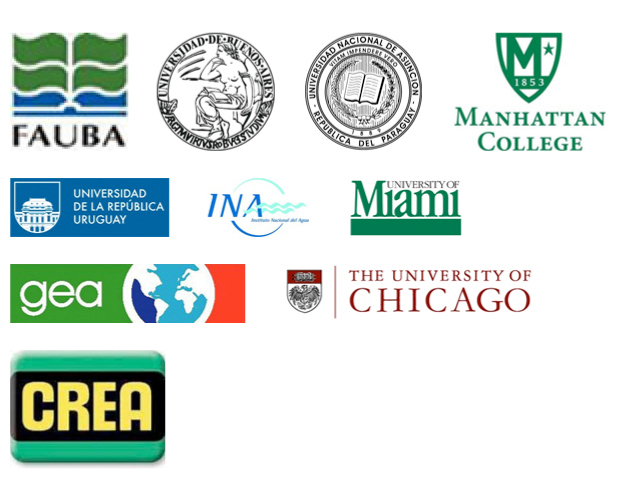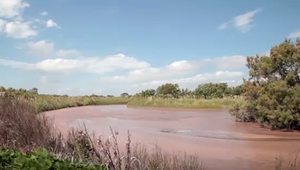From farm-level management to governance of landscapes: Climate, water and land use decisions in the plains of Southern South America (SGP-CRA 2031)

1) Modeled depletion of water tables in response to pasture establishment in 9 specific areas of the study basin. 2) Group activity during a workshop focused on floods and droughts in a town of the study region. 3) Screens capture of “Red mate” a crowd-sourced platform for the spatial and temporal monitoring of WT depth developed by project participants
Project information
Facultad de Agronomía, Universidad de Buenos Aires (Argentina)
This project follows the research started in CRN 2031, with the same title.
Executive summary Goals Some results Outreach Investigators Students
Executive summary
Groundwater is a major link between climate and food/energy production. In flat plains groundwater is close to the surface and can have either positive and negative impacts on natural and human systems depending on its depth. In turn, land use can have strong effects on the quantity and quality of groundwater. Being responsive to collective land use decisions, groundwater introduces interdependency among land users. Our main scientific questions: What are the two-way linkages between climate, land use and groundwater in the Pampas? What landscape management practices help maintain groundwater at optimal levels? What coordination approaches are needed to deal with groundwater interdependence?
Goals
Model non-linear and bidirectional relationships between groundwater, climate and land use decisions, focusing on the northwest portion of the Río Salado basin, in Argentina, a major agricultural area.
Some results
Land use affects water table depth (WTD) dynamics: pastures consume more water than agricultural crops (soybean, wheat-soybean double crop, maize) leading to deeper groundwater levels.
All agricultural activities consume similar amounts of water; none of them have advantages as a flooding-prevention strategy.
Land use decisions at a farm affect groundwater levels on neighboring ones. There is interdependence among spatially-close decision-makers.
Most farmers measure groundwater levels and make land use decisions based on this information. They are willing to coordinate actions in order to manage a common good.
Crowd-sourced web-based platform for the spatial and temporal monitoring of WTD in progress.
Outreach
In a dry region in which surface water course were unknown, new rivers started to appear. In just three decades tiny streams mutated into permanent brackish water currents that carve enormous valleys and bury fields, buildings and livestock. Water and mud are threatening the closest town and social unrest grows. Why is this happening? Why here? Why now? Settlers and scientists exchange their disconcert and search for explanations. Nature gives its own version of the facts, returning questions to the people. Can the current agricultural expansion be sustained? What human conflicts does it bring? This documentary was produced jointly with CRN 3095. Now with English subtitles!
Ranching is an important part of agricultural production in South America. Although there are more than 40 million hectares of degraded pastures in the region, silvo-pastoral systems can sustainably maintain both an economic activity, and near intact ecosystems and their services. We here present examples from the Argentine Chaco and the dry forests of Minas Gerais, Brazil. This movie is based on the results of the research of this project and one on conservation and management of tropical dry forests in the Americas (CRN 3025)
Conference on Water, a moving target
Estaban Jobbágy
Symposium Fertilidad 2015
29 May 2015
Project investigators
Esteban Jobbágy -UNSL, Argentina
Federico Bert – UBA, Argentina
Santiago Rovere – UBA, Argentina
Gervasio Piñeiro – UBA, Argentina
Marcelo Nosetto – GEA-UNSL, Argentina
Tamara von Bernard – GEA-UNSL, Argentina
Jorge Mercau – GEA-UNSL, Argentina
Angel Menéndez – INA, Argentina
Pablo García – INA, Argentina
Poonam Arora – Manhattan College, US
Guillermo Podestá – U. of Miami, US
Moira Zellner -U. of Chicago, US
Sebastian Mazzilli – UNR, Uruguay
Andrés Berger – INIA, Uruguay
Andrés Wehlre – UNA, Paraguay
Fernando Ruiz Toranzo – AACREA, Argentina
Students
Agustín Rocha, Undergraduate, Universidad de Buenos Aires, Argentina.Dean Massey, Master, University of Illinois at Chicago, USA.
Eduardo Conte, Other, Universidad de Buenos Aires, Argentina.
Eva Florio, Doctorate, Grupo de Estudios Ambientales, Argentina.
Evelyn Figueroa, Doctorate, Instituto Nacional de Tecnología Agropecuaria, Argentina.
Javier Houspanossian, Doctorate, Universidad Nacional de San Luis, Argentina.
Joaquin Lopez Laxague, Undergraduate, Instituto Nacional del Agua, Argentina.
Jorge Mercau, Other, Universidad Nacional de San Luis, Argentina.
Pablo García, Doctorate, Instituto Nacional del Agua, Argentina.
Raul Gimenez, Doctorate, Grupo de Estudios Ambientales, Argentina.
Santiago Rovere, Other, Universidad de Buenos Aires, Argentina.
Tamara von Bernard, Undergraduate, Universidad Nacional de San Luis, Argentina.


